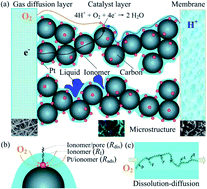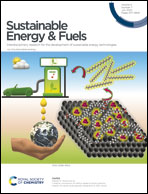Mesoscopic analyses of the impact of morphology and operating conditions on the transport resistances in a proton-exchange-membrane fuel-cell catalyst layer†
Abstract
Exploring the origins of local transport resistance and characterizing the oxygen transport resistances in the catalyst layer (RCL) are critical for cost reduction. In this paper, a comprehensive mesoscopic model for simulating coupled transport processes of oxygen and water vapor for different structural parameters under different operating conditions in reconstructed microstructures is proposed. The local transport resistance is calculated after achieving the limiting current density and the effective diffusivity of oxygen. The results demonstrate that RCL increases greatly with decreasing platinum loading (LPt) and the transport resistances in other components of the cell dominate for high-loadings. Both the reduced oxygen permeation coefficient in the ionomer thin-film and the adsorption resistance account for the origins of local transport resistance. The local transport resistance increases with the bare carbon ratio for a constant LPt and Pt/C ratio due to the decreased effective ionomer surface, and increases with the I/C ratio due to the increased ionomer thickness and decreased Knudsen diffusivity. Due to the presence of liquid water, a slight decrease followed by an increase of the local transport resistance versus relative humidity is obtained. The contribution of ionomer thin-films to RCL is more sensitive to liquid saturation compared with that of pores.



 Please wait while we load your content...
Please wait while we load your content...
